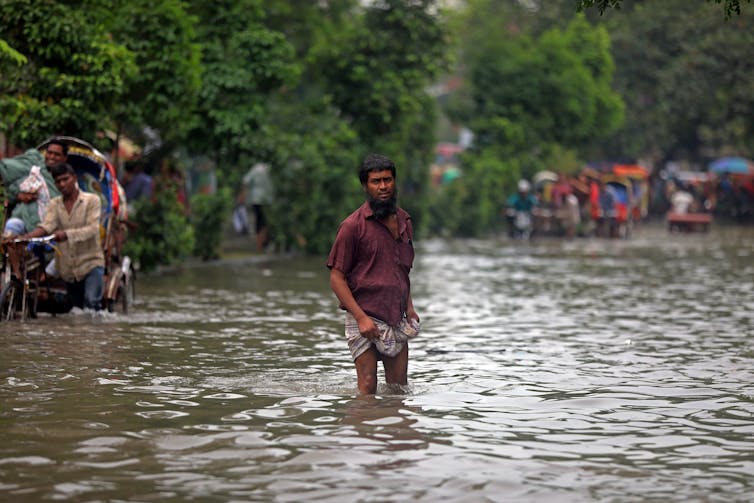Bangladesh’s accession to the UN Water Convention has a ripple effect that could cause problems with
Bangladesh’s ratification of the UN Water Convention could increase the nation’s legal clout in transboundary water governance.

When Bangladesh became the first country in South Asia to join the U.N.’s Water Convention earlier this year, it was presented as a win-win.
Signing up to the Convention on the Protection and Use of Transboundary Watercourses and International Lakes would help Bangladesh safeguard and manage waterways that represent a “lifeline to peace and prosperity,” according to the United Nations. At the same time, it was hoped that the South Asian nation’s addition might encourage better cross-border cooperation in a region where shared rivers are often fought over.
As a scholar who works on issues of water security and grew up in South Asia, I understand the drivers behind Bangladesh’s decision to join the convention – recent hydro-political events have raised water security risks for the country of around 174 million.
But contrary to the intention of the convention, I believe Bangladesh joining could actually heighten tensions in South Asia, especially with India.
The need for water security
Bangladesh’s hydro challenges are multifaceted. Half of Bangladeshis live in areas that suffer severe drought. Around 60% of the population is vulnerable to high flood risks. And on average, floods inundate 20% to 25% of the country’s land each year. Moreover, more than 65 million residents still lack access to safe and properly managed sanitation facilities. These overlapping vulnerabilities show why water governance is such a key issue for security, diplomacy and development.
Additionally, the country’s rising population along with the effects of climate change add to this domestic water stress. At least 81 of the 1,415 rivers that flow through Bangladesh have either perished or are on the brink of extinction, according to a recent report.
At the same time, Bangladesh relies almost exclusively on rivers that cross borders. With India and China, it shares one of the world’s most complicated transboundary water systems: the Ganges-Brahmaputra-Meghna Basin.
Joining the UN Water Convention
A number of recent developments underscore the reasons Bangladesh sought greater legal and international protection.
In July 2025, China announced what is expected to be the world’s largest hydropower dam, the Motuo Hydropower Station in the Tibet Autonomous Region in southwestern China.
The Chinese government is promoting the dam as a clean energy project that will help the area’s economy grow, even though it will cost 1.2 trillion yuan (about US$167 billion) to build.
But countries close by are worried about how the dam will affect the region’s environment and politics.
Both Bangladesh and India have complained that the project could make the region less stable. The Yarlung Tsangpo River on which the dam is built runs into India’s Arunachal Pradesh state, which has long been a flashpoint in China-India relations. China claims the region as its own and calls it Zangnan.
Because of where it is situated, the dam could allow China to control or limit the flow of water into India. Similarly, Bangladesh, a downstream country, is concerned that Chinese upstream intervention could hurt its agriculture and make it harder to get water.
Already, the government of Bangladesh has limited control over the country’s water supply because only about 7% of the watershed area of the Brahmaputra, Meghna and Ganges – the three main rivers that flow into the country – are within Bangladesh. Moreover, the amount of water that ultimately reaches Bangladesh is significantly reduced because dam activities by China and India have limited the flow.
Climate change has made the situation worse by changing the way water flows across the Himalayas and the Ganges-Brahmaputra-Meghna basin. For instance, the Bangladesh delta, one of the most fertile and densely populated areas in the world, is already experiencing problems, including salinity intrusion, rising sea levels and the loss of arable land.
In 2019, the Bangladesh High Court ruled that the country’s rivers had the same status as a “legal person” in a bid to award them further protection. This was then followed by a decision by Bangladesh to join the U.N. Water Convention.
Created in 1996, the convention seeks to promote cooperation and sustainable management of shared water resources. At first, it was intended only for European and Central Asian countries. But in 2016, it became available to all U.N. member countries.
Bangladesh had initially delayed signing due to a mix of diplomatic, regional and institutional reasons and out of a concern over how it would affect relations with its powerful neighbor, India.
Implications for India
India has traditionally preferred bilateral agreements to resolve cross-border water issues, such as the Indus Waters Treaty with Pakistan and the 1996 Ganges water-sharing treaty with Bangladesh.
However, India’s bilateral strategy is fraying. The Indus Waters Treaty has been temporarily suspended following fighting between Pakistan and India.
Similarly, New Delhi’s water cooperation with Bangladesh is being tested. The sharing of water from the Teesta, a major tributary of the Brahmaputra, has long been a source of conflict between the two countries, with Bangladesh pushing for what it sees as a fairer distribution.
Bangladesh has also opposed Indian dams, such as the Tipaimukh on the Barak, over concerns about how they will affect the environment and people’s lives. For similar reasons, Bangladesh has objected to India’s plans to connect 30 rivers as part of a massive irrigation project.
The ripple effect
While India’s government has issued no official comment on Bangladesh’s joining the U.N. Water Convention, there are fears in New Delhi that it could undermine India’s negotiating power in future water disputes and when the Ganges River Treaty is due for renewal in 2026.
The original 1996 agreement sets out that India and Bangladesh would each get a guaranteed share of 35,000 cubic feet per second of water. The concern in New Delhi is that Bangladesh may ask for more water than originally specified and that being part of the U.N. Water Convention gives the Bangladesh government a more powerful negotiation platform. As such, Bangladesh’s proposition in September 2025 to create a new institutional framework to manage water-sharing agreements with India for 14 transboundary rivers was viewed with suspicion in India.

Renewing the Ganges River Treaty with a framework that gives Bangladesh more water may put more stress on eastern India, an area already experiencing water scarcity, and test India’s water storage capacity, especially during dry seasons.
Shifting political currents
A further concern for India is that Bangladesh signing onto the U.N. Waters Treaty may set a precedent for other countries in the region, such as Nepal and Bhutan.
Meanwhile, Bangladesh has mulled the idea of forming a trilateral hydro-cooperation with China and Pakistan – two of India’s biggest rivals. A day before signing the U.N. convention, Bangladesh joined China and Pakistan in announcing a ‘trilateral cooperation’ on the economy, climate and social development.
For Bangladesh, the potential catastrophe of not tackling cascading environmental challenges justifies the risk of alienating its far more powerful neighbor. But where does this leave India? Ultimately, New Delhi must make a strategic choice: Either stick with bilateralism or adopt new multilateral norms to safeguard its water security and regional power.
Pintu Kumar Mahla is affiliated with the Water Resources Research Center, the University of Arizona. He is also a member of the International Association of Water Law (AIDA). Pintu Kumar Mahla has not received funding related to this article. The perspectives presented in this article reflect the personal positions of the author alone.
Read These Next
3 states are challenging precedent against posting the Ten Commandments in public schools – cases th
New laws mandating the Ten Commandments’ display in schools have faced lawsuits in Texas, Louisiana…
A culinary educator and local dining expert breaks down Michelin’s debut Philly list − and gives zer
The Michelin awards will almost certainly bring more tourism to the city, and more revenue to the honored…
Girls and boys solve math problems differently – with similar short-term results but different long-
The reasons are not yet fully understood, but researchers consider societal influences that encourage…





